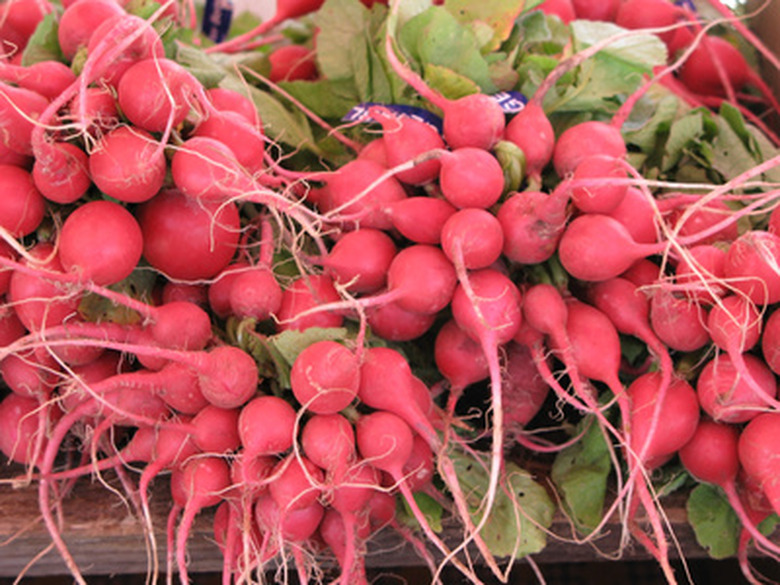The Effects Of Radiation On Germinating Radish Seeds
A popular theme for student science fair projects, exposing radish seeds to levels of radiation can affect their germination, creating mutations to the plant's usual behavior. For the scientific hobbyist, typical radiation sources include microwaves and ovens. Scientific studies have also tried subjecting radish seeds to various kinds of irradiation, either intended to protect radish plants from diseases or improve their overall productivity.
Improved Disease Resistance
Subjecting radish seeds to radiation significantly reduced traces of E. coli bacteria, according to researchers at Japan's National Food Research Institute. The treatment also worked on alfalfa, mung bean and broccoli plants to varying degrees of success. For best results, scientists first applied dry heat to the seeds for a 17-hour period, then applied the radiation. However, this level of radiation had no effect on the rate of seed germination. In separate trials, the same researchers found that an increased radiation level, of 2.5 kGy, completely eliminated E.coli when combined with the dry-heat treatment. However, the 2.5 kGy irradiation treatment did affect germination, decreasing the radish sprouts' lengths. Neither alfalfa nor mung bean sprouts were so affected.
- A popular theme for student science fair projects, exposing radish seeds to levels of radiation can affect their germination, creating mutations to the plant's usual behavior.
- However, the 2.5 kGy irradiation treatment did affect germination, decreasing the radish sprouts' lengths.
Improved Growth Rate
Exposing radish seeds to low levels of gamma rays affected germination and early growth as well as antioxidant content, according to a study published in the Korean Journal of Horticultural Science and Technology. Those seeds exposed to gamma radiation grew upon germination to become 8 to 14 percent larger than regular seeds. Those seeds that were radiated and then stored for up to 12 months did not demonstrate any changes. The irradiated and stored seeds even germinated somewhat slower than regular seeds. However, seeds that were left to germinate directly following radiation demonstrated faster germination, whether grown at room temperature or at 10 degrees C. The trials used radiation levels of 4 Gy, 8 Gy, 16 Gy and 32 Gy. Those exposed to 4 Gy had leaves 36.6 percent longer than the control group. Those exposed to 8 Gy had 8 percent higher antioxidant activity. Overall, the best radiation level was 16 or 32 Gy, demonstrating early growth as well as improved size and antioxidant activity.
- Exposing radish seeds to low levels of gamma rays affected germination and early growth as well as antioxidant content, according to a study published in the Korean Journal of Horticultural Science and Technology.
Seed Respiration
In an experiment carried out by the Market Quality Research Division of the U.S. Department of Agriculture, researchers found that radish, like wheat, corn and sorghum, displayed different respiration rates during germination when exposed to gamma radiation. Scientists used different levels of radiation, including 5, 20 and 80 krad. 80 krad of radiation slowed and stunted the germinated seeds' growth and interfered with respiration. The researchers measured respiration by monitoring the oxygen levels within the closed atmosphere where the plants were grown.
References
- National Institutes of Health: Combination treatments for killing Escherichia coli O157:H7 on alfalfa, radish, broccoli, and mung bean seeds.
- National Institutes of Health: Chemical and irradiation treatments for killing Escherichia coli O157:H7 on alfalfa, radish, and mung bean seeds.
- National Institutes of Health: Effects of Low Dose γ-ray Irradiation on Antioxidant Activity of Seeds and Seedling Growth in Raphanus sativus L.
- SciVerse Science Direct: Radiation-induced changes in respiration of corn, wheat, sorghum and radish seeds during initial stages of germination in relation to subsequent seedling growth
